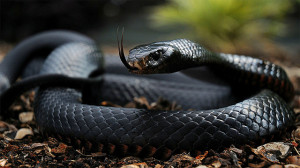
First aid for snake bites
Few unexpected events can put a damper on enjoying the outdoors more than a snake bite.
Fortunately, most snakes living in North America are not poisonous. There are some exceptions however, including copperheads, rattle snakes, coral snakes and water moccasins. Out of all the venomous snakes in North America all but the coral snake share a common trait, in that they all fall into a classification of snakes known as pit vipers. Pit vipers have eyes that are more slit-like in appearance, and all have triangular-shaped heads that feature pits on both sides of the head that are centered between the nostril and the eye.
The first step in protecting yourself is being able to identify poisonous snakes. Coral snakes can be recognized by the series of black, yellow and red rings that cover their entire bodies, but can easily be confused for king snakes. Water moccasins have a white lining covering the inside of their mouths. Rattlesnakes often issue a warning when they perceive trouble drawing near by shaking the segmented ends of their tails, creating the rattling sound for which these snakes are known, but the non-poisonous hognose snake mimics this behavior by shaking it’s tail in the leaves.
Bites from any of these snakes are potentially life-threatening, but it is possible to survive the ordeal if you follow the appropriate first aid steps.
The first step to lessening your risk of sustaining a snake bite boils down to common sense – if you see a snake, don’t touch it. Move slowly away from the animal instead; snakes usually prefer to avoid contact with humans whenever possible, and will usually only bite if they are surprised or feel threatened.
What to do of a snake bites you
- Calm down. Take a deep breath.
- Immediately cease movement of the bitten arm or leg, and remain quiet and still. Doing so will hinder the spread of the poison throughout your body.
- Take off any jewelry you may be wearing before swelling sets in.
- If possible, position the bite so that it lies beneath your heart.
- Clean the site of the wound and then apply a clean dressing to keep it covered. Do not flush the bite area with water.
- The area of the wound can be further immobilized with the use of a splint, but be sure to secure it loosely so you don’t impede blood flow.
- Never use a tourniquet, or ice the wound.
- Do not make an incision in the wound or do anything else to try to extract the poison.
- Do not ingest caffeine or alcoholic beverages
- Do not attempt to retrieve the snake. Instead, do your best to recall the snake’s overall appearance so you can describe it to medical personnel – that information can be helpful to those administering treatment.
Seek medical attention as soon as possible, particularly if you notice changes in the color of the bite wound, increased pain or inflammation.
If you are ever the victim of a snake bite, remember these guidelines – you may have a great survival tale to tell the next time you’re swapping stories around the campfire!
Bio
Jeremy Knauff is a Marine Corps infantry veteran, a husband and father, and the founder of How To Survive It, where he helps people develop survival skills and learn to become more self-reliant.
Like this post Consider signing up for my email list here > Subscribe
Think this post was worth 20 cents? Consider joining The Survivalpunk Army and get access to exclusivecontent and discounts! |
Also please enter our Reader appreciation contest and help spread the word about our blog.
Looking for the best prices and best customer service in buying Silver and Gold online? Look no further than JM Bullion for all your precious metal needs!
Looking for Camping and Survival gear? Need to Stock up on Fish antibiotics? Head over to Camping Survival!

Looking for improve your morning cup of coffee? Check out Mai Thai Coffee and stock up on the most important Prep!




Instead of retrieving the snake, if it is still around, you could photograph it, since almost everyone has a smart phone these days. A picture is worth a thousand words, as long as you don’t re-endanger yourself.